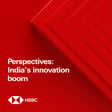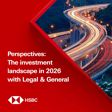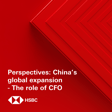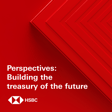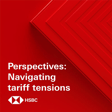Become a Creator today!Start creating today - Share your story with the world!
Start for free
00:00:00
00:00:01

The Macro Brief – Going for gold
James Steel, Chief Precious Metals Analyst, looks at what’s behind gold’s surge to record highs and considers where prices could go from here.
Disclaimer: https://www.research.hsbc.com/R/101/zj6g9gz
Stay connected and access free to view reports and videos from HSBC Global Research follow us on LinkedIn https://www.linkedin.com/feed/hashtag/hsbcresearch/or click here: https://www.gbm.hsbc.com/insights/global-research.
Transcript
Introduction & Podcast Overview
00:00:02
Speaker
Welcome to HSBC Global Viewpoint, the podcast series that brings together business leaders and industry experts to explore the latest global insights, trends, and opportunities.
00:00:13
Speaker
Make sure you're subscribed to stay up to date with new episodes. Thanks for listening, and now onto today's show.
00:00:24
Speaker
This podcast was recorded for publication on the 24th of April 2025 by HSBC Global Research. All the disclosures and disclaimers associated with it must be viewed on the link attached to your media player.
00:00:35
Speaker
And remember to like and subscribe to The Macro Brief wherever get your podcasts.
Gold Prices: Recent Trends & Analysis
00:00:49
Speaker
Hello, I'm P.S. Butler and welcome to The Macrobrief, our weekly look at the issues driving financial markets across the globe. As market uncertainty and volatility continue to rattle investors, one asset that has seen a big rise is gold.
00:01:03
Speaker
Prices surged to record high earlier this week, topping $3,500 ounce.
00:01:10
Speaker
And although prices have fallen back since then, bullion is up over 20% from the start of the year. So to look at what's behind the surge and where prices could go from here, I'm joined from New York by James Steele, our chief precious metals analyst.
00:01:23
Speaker
Jim, welcome to the podcast. Thank you, Piers. Thank you for having me. Well, we were very keen to have you on the podcast, given all the headlines that we keep seeing on gold. And in some respect, I guess it's understandable given its traditional safe haven role.
00:01:37
Speaker
ah But we are talking about multi-year highs, which few, I guess, would have predicted. Perhaps to sort of put it into context, ah how high is gold in real terms? I mean, adjusted for inflation.
00:01:50
Speaker
Yes. Now, gold has, as you quite rightly say, gold has made a series of repeated highs in nominal terms all this year, and in fact, last year as well. But gold has only recently highs in real terms.
00:02:04
Speaker
The previous high in real terms was January of 1980, when gold hit $850 an ounce. And that was the same month that Volcker was appointed to the Fed, and it was in the waning days of the Reagan administration took over.
00:02:20
Speaker
Now, if you use the CPI deflator from the Department of Commerce, that puts gold at just a shade under $3,400 ounce. So this week, when we went above to touch
00:02:37
Speaker
we went into not only real highs in nominal terms, but also in real terms. So let's try and understand what what's driving this. Because as you say, when you look at ah a chart of gold in real terms, it's it's taken a long time to get back to ah this previous historic high.
00:02:57
Speaker
You talk about the fact that there are in fact 12 to 15 factors that tend to drive the market for gold. But the trick is knowing which ones are in the driving seat.
Geopolitical Influences on Gold
00:03:08
Speaker
I guess one of the important ones at the moment and has been for a few years now is geopolitics. Yes, that's absolutely correct. Geopolitics is central, I think. Geopolitical risk and the rise in the geopolitical risk thermometer globally is central to why we're so high right now.
00:03:28
Speaker
And, you know, analyzing geopolitical risk and gold, it's very interesting because, you know, you can say to me, Jim, what happens ah to gold if the Fed cuts 100 basis points? Or what happens to gold if the dollar depreciates by 2%?
00:03:42
Speaker
Or what happens when the equity markets do this? And I can go back and I look can look at the empirical information, the data, and I can come them up with some sort of an idea. But ah quite frankly, this does not apply. You cannot model geopolitical risk in the same sense.
00:03:59
Speaker
Ukraine is different from Gaza, is different from the issues in the South China Sea, et cetera, et cetera. So it's very difficult. It makes um any kind of quantitative modeling ah virtually impossible, except that we do know that when geopolitical risks rise, it obviously has a negative impact on capital markets and increases the demand for safe havens.
00:04:23
Speaker
principally, which is gold.
Debt & Economic Policy: Impact on Gold
00:04:25
Speaker
And Jim, you also say in your report that debt is a friend of gold. Why do you say that? Well, yes, that's right. And I think we have to make a distinction between private debt and public debt.
00:04:35
Speaker
Private debt is is my debt. It's your debt. It's the debt of a company, be it a large ah multinational or a small or small corporation. and whereas And the gold market is relatively insensitive to that debt.
00:04:50
Speaker
And I think a movement's in that debt. And I think that's because the gold market is populated by free marketeers who believe that if Jim Steele borrows too much or if a company borrows too much, one way or another, they they'll be restrained. The market will punish them.
00:05:06
Speaker
Whereas we all know that governments have more largesse, don't we? They can, bar particularly G10 governments, can borrow much more And gold is sensitive to that, partly because too much government debt can impact the capital markets, dislocate the capital markets.
00:05:22
Speaker
There's the crowding out theory that you don't get enough private investment. ah It can be inflationary. It can be monetized. And all of those things lead us to search for greater safe havens more and hard assets, of which gold is gold is number one.
00:05:39
Speaker
And if you look at recently, the um IMF have warned about the increase in debt to GDP ratios worldwide. Clearly, the other factor, more recent, is the current economic environment with dramatically increased uncertainty.
00:05:54
Speaker
Is that why the relationship between gold and real yields has broken down? I mean, traditionally, as as you have written, when you get high real yields, ah that that tends to be not so good for gold. But but but that relationship seems to have broken down recently.
00:06:11
Speaker
Yes, it has. And in fact, one of the most, you know, when you're you're an analyst and looking at something like gold, you search for relationships. You look U.S. dollar, ah gold, treasuries, gold, equity markets, et cetera, et cetera.
00:06:26
Speaker
And one of the the the longest lasting relationship was the inverse relationship between real yields on the U.S. 10-year specifically and the gold price. And when we went negative, when real yields went negative,
00:06:39
Speaker
such as during global financial crisis, during COVID, gold market did very well. Periods when it went positive, the gold market tended to weaken. That broke apart towards the end of 2022. And I think there were a number of reasons for that, but namely economic policy uncertainty because of increasing inflation.
00:07:01
Speaker
This is when you also got large central bank buying and very large retail coin and bar buying as well. but Further to the point of economic uncertainty, we looked at the economic policy uncertainty index, and we found a decent correlation with with with gold.
00:07:20
Speaker
And what I want to stress here is not so much economic distress. One can argue if an economic policy is good or if an economic policy is is is bad, depending upon your your view.
00:07:32
Speaker
But what the market, if the gold market really latches onto is uncertainty. and And let me just take a ah brief view to to history. One could have agreed with Mrs. Thatcher and Ronald Reagan, or one could have disagreed with them.
00:07:44
Speaker
The fact of the matter was that they had great clarity with their policy. Everybody knew what they were going to do. Currently, the economic policy climate in many countries is not clear.
00:07:56
Speaker
And this is what's driving the gold.
Market Dynamics & Gold Demand Changes
00:07:58
Speaker
So with all this rise in nominal and indeed real value of gold, how has this impacted the physical market for gold?
00:08:09
Speaker
And is it fair to say that as HSBC, we are particularly well-placed to have a view on this? Yes, indeed. And not wanting this to be a party political broadcast for HSBC, but we stand really at the head of this combination of the investor market and the and the physical market.
00:08:29
Speaker
We are deeply involved. We are a major exporter to China and India, ah who consume 50% of the world's gold between the two of them. Also, jewellery, refining, recycling, mints, mines. We are involved in this. And and through through hedging and managing, we're able to to have a feel for the rhythm of the physical market. and i'm And I'm glad you brought it up because it's something that's not being talked about.
00:08:56
Speaker
We are seeing outright demand destruction. ah because of the high price. ah Jewelry demand is down double digit. That's 50% of all physical gold demand.
00:09:07
Speaker
And I'll give you an example. The 10 gram bar, not very big, and is the favorite bar in India, major consumer of gold. It was 35,000 rupees just a few years ago.
00:09:18
Speaker
It is now around 100,000 rupees because the rupees also weakened to the dollar. This is pricing gold out of the market. Now, This doesn't matter as long as there are plenty of investors to absorb this gold.
00:09:30
Speaker
And that has been the case so far. But coins are coming back into the market. The demand for small bars is falling and the demand for jewelry is dropping. When you say that so there's still been demand, is that because of the creation of of ETFs and and gold ETFs have been enormously popular?
00:09:47
Speaker
Yes, they weakened for quite a number of of years. they they They hit and we were at the forefront of creating ah the world's first gold ETF with the World Gold Council.
00:09:58
Speaker
And we store a large portion of the world's ETFs in our vaults. um And ah it was successful, very successful up until COVID and through COVID and then dropped, but have have come back at the beginning of this year.
00:10:15
Speaker
And also we've seen an increase in Chinese based ETFs. And all of this is adding to the investor demand. So but a bit of a curveball here, but why have millions of ounces of gold shifted to New York warehouses? That seems like a bit mysterious.
00:10:30
Speaker
Well, yes, and the last time it did, and um and this is where it gets a bit technical because you talk about the exchange for physical market, the EFP market. ah This happened during COVID, by the way, ah when it looked as if U.S. gold refineries were going to close or we weren't going to be able to get enough pilots to to bring the gold from London to New York. London is the center of the physical market.
00:10:55
Speaker
um New York is the center of the futures market on the the old COMEX, which is now called the CME. And when you if you get a threat of tariffs in this case, which was a possibility of say 10% tariffs going on bullion coming out of London, that would have thrown the the physical price up 10%. It would have created ah massive difference on the EFP And therefore, in order to safeguard that we would have enough gold to meet these contracts, ah millions of ounces of gold shifted ah from London and other places into New York.
00:11:32
Speaker
Now, the EFP has since come in because it's quite apparent that bullion has had exemptions to the tariff. but we didn't know earlier in the year. And consequently, that gold flooded in.
Gold as a Reflection of Global Events
00:11:45
Speaker
It is now beginning to move back out, which it also did during COVID, by the way. It came in and then it moved back out again. So, Jim, it's fair to say you're still a young man, but you have looked at precious metals and gold in one way or another over the last 40 years. And I'm sure you've seen many ups and downs.
00:12:02
Speaker
But how significant is the current price spike in the context of all that history? Well, it's taken ah quite an emotional, physical and mental toll on me, as you can imagine, Pierce, but it is a fascinating market.
00:12:15
Speaker
It is intellectually, it's very, very challenging. And there's very few markets where you can move all the way from fashion and design and adornment through investment, through geopolitics, through macro and microeconomics. It's got the whole thing.
00:12:30
Speaker
and and And what is interesting is that gold is a barometer for global events. And if one looks at gold, one can see how the public, how the investor public is reacting to government policies, is reacting to what is happening in the world.
00:12:46
Speaker
I'll point out in the 1990s, gold was very weak. And there's no doubt that the end of the Cold War and the reduction in geopolitical risks contributed to that.
00:12:57
Speaker
Well, in the last few years, those risks have been back up. so So an observation of the gold market really puts you in the eye of the storm, if you like. And that's that's why I think it's such an interesting ah market. And despite the fact that many other physical things have have gone by the by, gold is still useful in ah and a port for portfolio diversification.
00:13:19
Speaker
Okay, so toughest question last, Jim, but where do we go from here? Well, I think we're going to see, I think think the last couple of days showed us that any positive comments, and we got some positive comments on trade, on tariffs coming out of the White House, and also a pullback from criticism of the Fed and retraction on the White House yeah calling for Powell's dismissal.
00:13:47
Speaker
And then the gold market dropped very quickly. um Overnight, we've seen perhaps less progress on the trade issue coming out of China then than had been hoped for, and the gold market has come back again.
00:14:00
Speaker
So I think we're going to be very sensitive to headlines. And we have to wait for the geopolitical risk thermometer to come, whether that be a settlement in Ukraine, whether it be some progress on tariffs and over time. And that will be the driver of gold coming lower. And that will be when the heavy increase in the physical side of the market through a lack of demand and increased supply, by the way, will begin to weigh on prices. But until then, we're going to be powerful and volatile.
00:14:29
Speaker
Jim, that's a great insight. And no doubt there'll be many more twists and turns in this market. ah But for now, thank you very much for
Future Discussions & Accessing Research
00:14:37
Speaker
joining us. Thank you.
00:14:42
Speaker
Hello, Macrobrief listeners. Fred Newman here in Hong Kong. The tariff story clearly isn't going away anytime soon. And as always, we've got our finger on the pulse here in Asia. Join me in a room full of my fellow economists on this week's episode of Under the Banyan Tree. We'll be discussing the outlooks for Japan, Korea, Taiwan,
00:14:59
Speaker
Vietnam, and many more economies. That's Under the Banyan Tree from HSBC Global Research. Find us wherever you get your podcasts.
00:15:11
Speaker
Before we go, a reminder that HSBC clients can keep up to date on our latest research by downloading our app from Apple's App Store or Google Play. You can get in touch with us if you have any questions or comments about the podcast.
00:15:23
Speaker
Just email askresearch at hsbc.com. And finally, a quick note about another series of podcasts from HSBC. Recorded behind the scenes at our Global Investment Summit in Hong Kong, Perspectives features conversations with special guests on topics ranging from trade to AI.
00:15:41
Speaker
The latest edition includes global researchers Paul Mackel and Stephen Major talking about developments in the currency and fixed income markets. To listen, just search for HSBC Global Viewpoint wherever you get your podcasts.
00:15:56
Speaker
And don't forget to subscribe to The Macrobrief while you're there.
00:16:02
Speaker
So that's all from us this week. From all of us here, thanks for listening. We'll be back next week with another edition of The Macrobrief.
00:16:39
Speaker
Thank you for joining us at HSBC Global Viewpoint. We hope you enjoyed the discussion. Make sure you're subscribed to stay up to date with new episodes.






